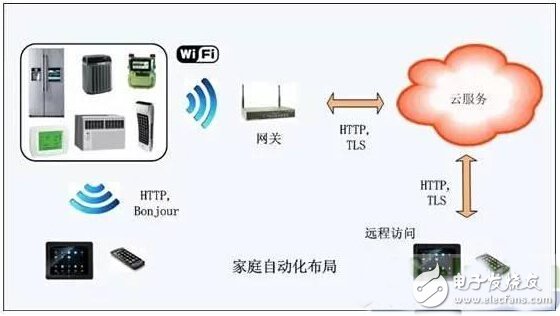When it comes to the inscrutable Internet of Things (IoT), the most grounded air is the smart home access to the Internet. The household appliances are connected to the broadband network through the home gateway, and are sent to the cloud for information exchange and communication, which can realize identification, positioning, tracking and remote control. The smart home networking system can include an embedded microcontroller (MCU), a wireless connection, a software platform, and an application software APP. This article introduces a set of living home networking solutions that span the threshold of conceptualization and landing, and come into reality, at your fingertips.
First, the system consists of
In a typical application scenario, a home appliance networking system consists of a microcontroller, a gateway, a controlled item, and an access control device. Isolated items (refrigerators, air conditioners, cars, meters, etc.) access the network world and can communicate with each other to form an intelligent network. The user can realize the information collection analysis and intelligent management of the controlled object through the tablet or the mobile phone, and can also go online for remote operation.

As can be seen from the above figure, the home automation system integrates embedded microcontroller technology, wireless connectivity, and access network. Apps software enables users to discover devices at home, set them up, or create an action to control them.
Remote control allows you to "discover, manage, and control" anytime, anywhere, no matter where you go. For example, if you are traveling, you can still monitor the safe environment of your home and adjust the indoor temperature of your home.
The microcontroller single chip includes wireless connection functions and is classified according to different wireless connection protocols to form WiFi, Bluetooth, Zigbee and other series.
Second, the key components
Microcontrollers are a key component of home intelligence. MCU and Wi-Fi are the two basic elements. Take a Wi-Fi microcontroller as an example. It is a single-chip SoC with a full-featured microcontroller that supports 802.11n Wi-Fi.

Third, the software features
Wireless technology has a high threshold, and only IP is difficult to integrate into a finished product. Device manufacturers need to innovate in IoT applications and shorten the design cycle to market quickly. As a provider of microcontrollers, it is necessary to provide design tools and technologies for application integrators to support ODM and OEM ecosystems. Therefore, software development tools are also an indispensable part.
The software platform should include software development kits (SDKs) and application programming interfaces (APIs) to help developers fully exploit the potential of built-in microcontrollers in SoC solutions, making it easy for system integrators to integrate and deliver mature and stable systems. And greatly reduce the time to market.
Software for Wi-Fi microcontrollers has the following features:
Simple and fast configuration deployment of Wi-Fi Headless devices with proprietary tools;
Built-in integration with IoT cloud service provider services, a full suite of middleware components supporting industry-standard Web protocols including HTTP, TLS/SSL, BSD Socket, Web-Socket, JSON, and XML parsers to enable efficient cloud services Connection
Support for mid-air firmware upgrades, which can be added to any application by simply writing a few lines of code;
Flexible communication mode enables P2P applications, device-to-device communication, seamless integration with mobile clients and cloud services;
From WiFi to the application layer, there are multiple layers of security mechanisms to achieve secure deployment and prevent damage to user privacy;
After field test verification, support the procedures required for product manufacturing including testing to make the product available quickly.
Fourth, the application scenario
Different application scenarios will use different microcontrollers. There are three main types of commonly used wireless connections to form a complete platform. In addition to supporting Wi-Fi 802.11n, there are also dual-mode Bluetooth 4.1 and 802.15.4/ZigBee-enabled microcontrollers.
Wi-Fi microcontrollers are the most common application scenarios, and are mainly suitable for long-term connection between white goods such as refrigerators, refrigeration and air conditioners, and home networks in smart homes.
The Bluetooth connection mode is suitable for use in close short-term situations, such as "interaction" between devices. The Bluetooth microcontroller is a single-chip SoC that supports dual-mode Bluetooth 4.1, integrated microcontroller and wireless connection, and realizes the coexistence of classic Bluetooth and smart Bluetooth. The built-in voice function supports high-resolution ADC and direct connection with microphone.
The ZigBee connection mode is suitable for building a mesh network with a large number of nodes such as lighting street lights. The number of nodes can be as high as 60,000. The ZigBee microcontroller is a single-chip SoC that supports 802.15.4/ZigBee, integrates a microcontroller and wireless connectivity, and is easy to interface with sensors, starters and other components, reducing external components and PCB area.
V. Industrial services
In order to meet more and more enterprise needs to achieve intelligent, service providers and developers work together to create a one-stop service, introducing an open development platform to connect home appliances with intelligent platforms, in terms of technology and applications. The enterprise provides a package service of Wi-Fi module + cloud service + APP. From 0 to product launch, build a complete industrial chain, including product plan development, module integration, function definition, linkage testing, cloud service construction, online release, etc. This process can be completed without the participation of technical personnel. .
Home appliance companies can choose multiple super apps to control devices to achieve inter-brand and cross-door product interoperability. The scened experience allows users to DIY different scenarios and trigger the management and operation of various smart products.
In short, smart home networking is a development trend. Based on a comprehensive wireless MCU hardware platform and software development kit (SDK), it constitutes a complete, flexible and easy to use core resource. ODM/OEM benefits from the accumulation of microcontroller technology, while improving performance, reducing power consumption, reducing materials, and leveraging the development platform, it is easy to launch innovative IoT products to form a smart solution that is close to life.
Table Top Gas Stove,Double Burner Gas Cooke,Mini Gas Cookers,Teflon Coated Gas Cooker
xunda science&technology group co.ltd , https://www.gasstove.be